#19th c menswear
Explore tagged Tumblr posts
Text
always rb good costume pix! LOVE the double waistcoat style of this era.
and again, note how every detail in the two designs, emphasizes and exaggerates. crowley is made taller and slimmer, aziraphale is made bulkier, wider, less tall. <3
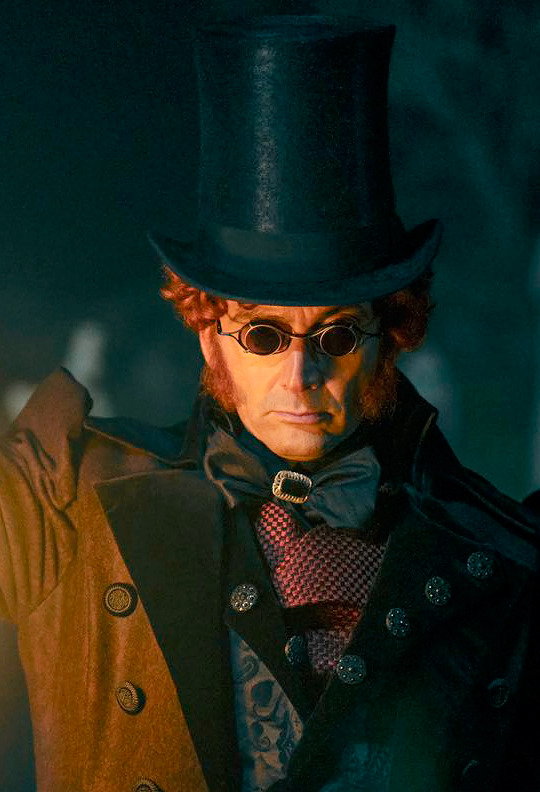
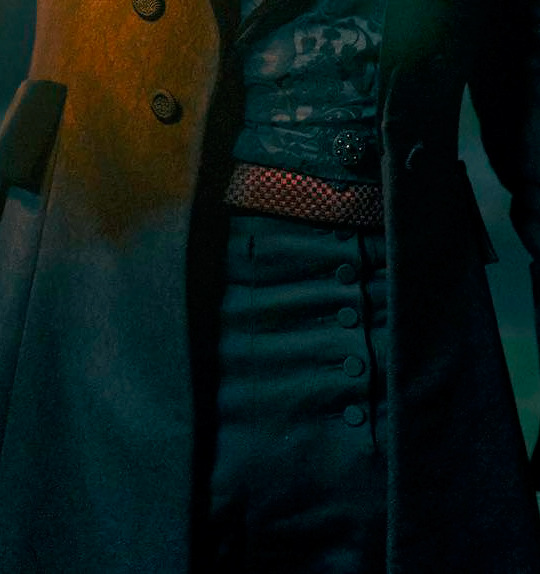
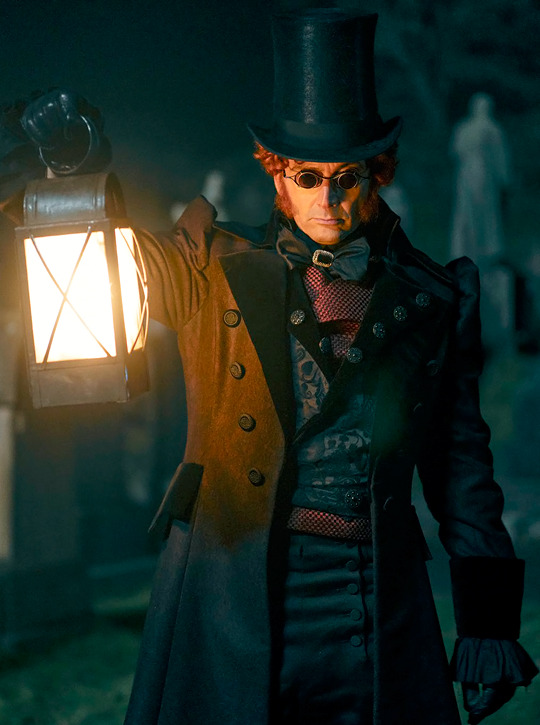

Crowley and Aziraphale in a graveyard in 1827 Edinburgh - Good Omens Season 2, episode 3
for Tennant Tuesday (or whatever day this post finds you)
#good omens#crowley#he's dressed like the dandiest dandy ever to dand#it's amazing#what a costume#good omens season 2#good omens costumes#good omens wardrobe#good omens 1827#19th c menswear#costume design#costume is character#costume details
2K notes
·
View notes
Text
since I'm only watching the serials that I really want to I've skipped ahead to mark of the rani and I must ask. what in the everloving hell is peri wearing
#it's not 1810s. at least. it takes inspiration from it but it's really not 1810s#her bodice really seems more 1520s menswear. slash and puffed and the texture too#I just checked when this serial would be set and it's c. 1814. her bodice's main colour at least is accurate if a fashion plate is#to be believed. but like. her waistline is too low those sleeves are. again it's really 1520s slash and puff#it's not inaccurate in its shapes but it seems to be a hodgepodge of various styles and I don't think I'm seeing anything that looks like i#in full#hell I've just stumbled across a fashion plate that looks VERY similar to what peri wears and it's so different!#skirt shape is different (though if this were the 1820s it would be more accurate) sleeves are different for daywear no bonnet#her skirt's too short and those heels. not only would those heels be evil for running in the early 19th century favoured a flatter shoe
4 notes
·
View notes
Note
I know 19th century menswear is more of your area of expertise, but what were the ladies wearing in the 1840s? As is usual when looking up historical clothing, I'm finding a lot of information about upper-class women's clothing, and not so much about what your average woman would have been wearing.
You are correct, women's clothing is not really my wheelhouse—but I have some great resources! I love to rec the Fashion Institute of Technology's decade-by-decade 19th century fashion time lines, which all include citations and references that you can follow up on.
Here's 1840–1849, with women's clothing first. The very elongated waist is visually distinctive, with a bell-shaped skirt, and (in evening dress) a very low-cut top with a lace bertha collar.
Another fave fashion history book is Handbook of English Costume in the 19th Century by Phillis Cunnington and C. Willett Cunnington, available on Internet Archive. They have a whole chapter on women's fashion 1840–1849, including accessories, hairstyles, etc.
It's more challenging for me to speak on working class women's clothing. Generally speaking, all social classes except for the extremely destitute (or absurdly rich) dressed in a similar manner. But poor women would use cheaper fabrics, update old dresses, and have less luxurious trim. One interesting fact about 1840s women's dress is while the fashionable silhouette has huge volume in the skirt, they were achieving it with horsehair petticoats and not crinolines. (I'm a little iffy on when exactly crinolines appeared, but I believe it's the 1850s to make giant skirts to match the gentleman's giant bowties).

Close of the Season—The London Footman Exhausted by John Leech, 1846. The servant women in this cartoon have aprons to protect their plain dresses, but the length and volume are pretty similar to upper-class clothing. The lace caps would also be worn by women of all social classes. I think that we often perceive Victorian clothing as being more upper-class than it really is.
Tagging @dresshistorynerd for someone who actually knows what they're talking about! (And everyone else who isn't a jerk is welcome to chime in).
30 notes
·
View notes
Text
so many words about historical men's corsetry
(This got way too long to send via Discord -- Dangimace in the Renegade Bindery server asked about men's corset sewing/resource recs so here is my half-assed and non-exhaustive rundown. Most of my historical sewing is focused on fashions of the UK, US, and Europe for the second half of the 18th century and first half of the 19th century, so that bias is reflected here; also disclaimer overall that "menswear"/"womenswear" are socially constructed categories and real people's bodies have always looked a wider variety of ways than fashion and other social forces would dictate. I sew historical garments with enthusiastic disregard for the historical gender binary and I'm barrel-chested, thick-waisted, and narrow-hipped no matter what I'm wearing.)
Onward, lads!
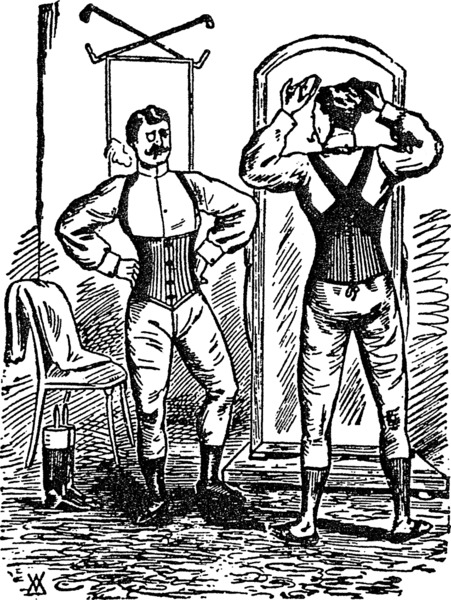
Ok wrt men's corsetry: there's a whole lot of fogginess around how historical men's corsets were constructed for a bunch of annoying reasons but that means there's lots of possibilities to explore in pattern drafting and project planning. Stays and other stiffened body-shaping garments have a whole complex conceptual relationship to the body basically as soon as they start appearing. 16th and 17th century garments do a whole lot of shaping (both compressing and building up) for men and women alike, but things really kick off in the 18th century in terms of the symbolic weight placed on stays and (later) corsets. Whole lot of stuff about gender, social class, race, fatness, morality, etc. getting projected onto these garments. So I'm a little leery about people taking obviously satirical illustrations of fashion-victim dandies or Gross Corpulent Libertines getting laced into corsets as truthful and indicative of the way men were really dressing -- scurrilous gossip and exaggeration are both a pain to sift through if we want to know which men wore corsets, what kind, and why.
In the very late 18th/early 19th century corsets were part of the repertoire for achieving highly fashionable shapes in menswear. (Along with a whole lot of padding.) They weren't mandatory for all dudes, but for fashion-forward dandies and equally fashion-forward military men, male corsets/stays were definitely a thing. The whole Romantic-era pigeon-breasted, narrow-waisted silhouette can be emulated by shapewear worn beneath the clothes, pads in the garments themselves, or both; in addition to waist reduction it helped to maintain smooth visual lines underneath close-fitting garments.
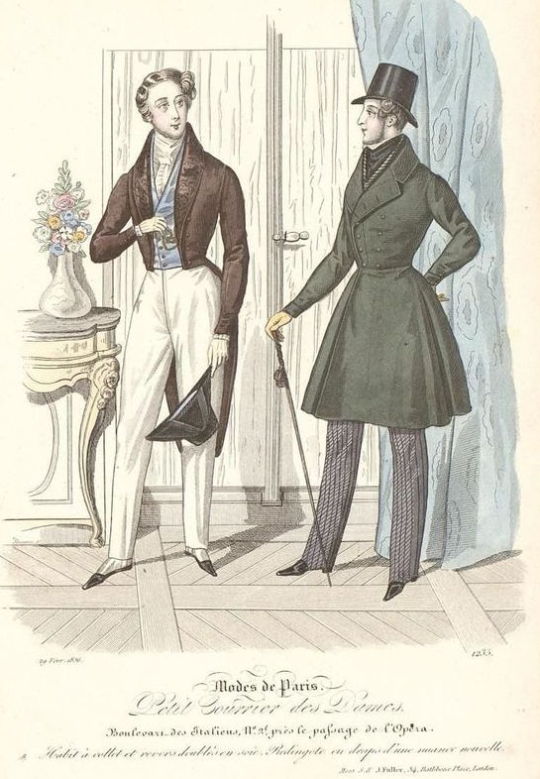
(look at these minxy 1830s dudes and their tiny waists)
As the century goes on the desired menswear silhouette becomes boxier and less fitted, and male corsetry recedes into the background; we start to see patents and advertisements for men's corsetry, so they still seem to have been worn, but there's a lot more language around vigorous manly athleticism and supporting the structures of the body. It can be hard to tell whether a particular piece is intended to be worn primarily for some medical purpose or for its perceived aesthetic benefits. This is giving me such flashbacks to trying to find post-surgical compression garments.
(Side note: there's also a vigorous tradition of fetishist writing about corsetry all through the 19th century, in fairly mainstream channels, which is fascinating. Due to the relatively private and deeply horny nature of fetish tightlacing we don't necessarily know as much about what those same letter-writers may have "really" worn at home, but I hope they were having fun.)
I've seen very few specifically men's corsetry patterns from historical pattern-makers-- not even really big names like Redthreaded. I sewed my 19thc menswear corsets from the men's underbust pattern in Laughing Moon Mercantile #113 which afaik is speculative rather than reproducing a specific historical garment, but it's not too different from the women's late-19th-century underbust patterns in the same pattern pack.
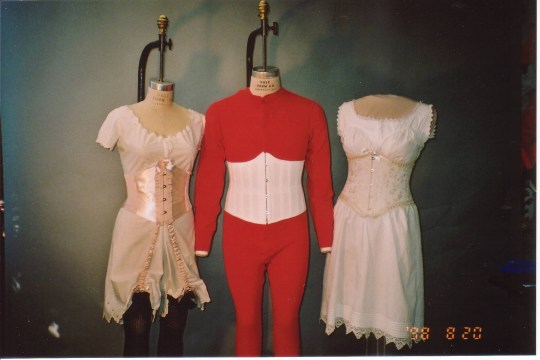
(image credit: LMM)
However, a lot of underbust and waist-cincher patterns from more general historical patternmakers could be made suitable with some minor alterations. Here I'd also rec books like Jill Salen's Corsets: Historical Patterns And Techniques and Norah Waugh's Corsets & Crinolines, though their focus is definitely on womenswear and you need to be relatively comfortable scaling up or drafting from pattern diagrams.
The structural features and desired results for a man's corset are pretty much the same as any other corset (back support, compression in some areas, etc.) even when the desired silhouette is different; commercially-created patterns are drafted with the expectation of certain bodily proportions so like with all corset-sewing it's important to make a mockup for fitting purposes. (I ended up liking one of my mockups so much I finished the process and made it a whole separate corset.) I don't know much about this area but I seem to see a lot more belt-and-buckle closures and criss-crossing straps in corsets designated as being for men -- this might be a byproduct of gendered differences in how people got dressed, but it might be nothing.
There's some weird and wonderful historical examples, both extant and in images -- I appreciated this post at Matsuzake Sewing, "A Brief Discussion Of Men's Stays", and its accompanying roundup of images on Pinterest though the tone wrt historical fetishwear corsets in the blog post is a little snippy. I really want to make a replica of Thomas Chew's 1810s corset (which you can read more about here at the USS Constitution Museum) but it incorporates stretch panels made with a shitload of metal springs and I'm not ready for all the trial and error trying to replicate that.

(image credit: USS Constitution Museum Collections)
There's a pretty rich vein of modern men's corset patterns which seem like they could be easily pattern-hacked for historical costuming purposes, like these with shoulder straps from Corsets By Caroline or DrobeStoreUpcycling's waist cincher which also looks like it could be altered pretty easily to cinch with straps and buckles like some 19thc men's corsetry does. This pattern for a boned chest binder in vest form by KennaSewLastCentury is also really cool but I didn't get a chance to sew it pre-top-surgery. (I think I've also seen someone who made a chest-compressing variation on Regency short stays, but I can't find it now.)
In general a lot of underbust and waist-cincher patterns should work just fine for silhouette-shaping without much bust/hip emphasis -- my usual resource for free corset patterns (Aranea Black) recently took down all her free patterns but they're definitely still circulating out there. For general fashion purposes the sky is the limit and there are a lot of enthusiastic dudes in corsets out there. This Lucy Corsetry round-up shows a variety of modern corsetiers' styles designated as being for men or more masculine silhouettes (including a SUPER aspirational brocaded corset with matching waistcoat made by Heavenly Corsets that I'd love to sew a historical spin on) and you can see some commonalities and possibilities for body-shaping.
I can also give some more general corset-sewing resources but I'm very much in the learning process here and I'd love any recs or input from people more experienced in pattern-drafting and corset-sewing.
123 notes
·
View notes
Photo

Written by Menswear Style in Travel on the 19th November 2024 When planning a trip to Bath, UK, understanding the city’s seasonal charm can help create an unforgettable experience. Whether you're eager to explore its Roman heritage, enjoy the rolling countryside, or simply relax at some of the best hotels in Bath, the season you choose can shape your holiday significantly. Let’s dive into what each time of year offers so you can find the best fit for your ideal vacation. Spring (March to May): A Blossoming Paradise Springtime in Bath is truly captivating. As the weather begins to warm, the city’s gardens and parks come to life. The blooming cherry blossoms and fresh greenery make this period perfect for long walks and outdoor picnics. Why Visit in Spring? Comfortable Temperatures: With average highs ranging between 10°C and 16°C (50°F - 61°F), the mild weather is ideal for sightseeing without the crowds of summer. Historic Tours: This season is a great time to explore Bath’s iconic landmarks like the Roman Baths and Bath Abbey. The weather is mild enough for walking tours, allowing you to fully appreciate the city’s Georgian architecture. Festivals and Events: Bath hosts a variety of spring events, including the Bath Comedy Festival in April and the Bath Festival in May, which celebrates music and literature. Spring also brings opportunities to explore the city’s hidden gems. Visit the Holburne Museum, set within the scenic Sydney Gardens, or take a leisurely stroll along the Kennet and Avon Canal. The vibrant wildflowers and tranquil waters make for a picturesque backdrop perfect for photography enthusiasts. If you're planning a stay, booking a boutique hotel in Bath during spring can provide an intimate and cozy base for your explorations. With fewer tourists than peak summer months, you’ll enjoy a more peaceful experience. Summer (June to August): The Height of Activity Summer is the most popular time to visit Bath, drawing travelers from all over the world. The city buzzes with life, and outdoor activities are at their peak. What Makes Summer Special? Warm Weather: Average temperatures range from 18°C to 22°C (64°F - 72°F), making it perfect for open-air concerts, al fresco dining, and exploring Bath’s lush countryside. Outdoor Attractions: Head over to the Royal Crescent’s lawn or the botanical gardens in Royal Victoria Park for a relaxing afternoon. You can also take a scenic boat ride along the River Avon for a unique view of the city. Events and Markets: The Bath Carnival in July is a vibrant celebration full of music, dance, and colorful parades. The local markets flourish with artisanal products and fresh produce, ideal for picking up unique souvenirs. Summer is also the ideal time to experience the city’s rooftop bars and outdoor cafés. Enjoy a refreshing afternoon tea on a terrace or sip cocktails as you watch the sunset over the historic skyline. The city’s calendar is packed with open-air theater performances and live music events that add to the summer ambiance. However, keep in mind that summer is the peak tourist season. Be sure to book accommodations and tickets for attractions well in advance to avoid disappointment. Autumn (September to November): A Golden Getaway As the summer crowds disperse, Bath takes on a more tranquil and golden hue. The autumn months are perfect for those who appreciate crisp weather and a more relaxed atmosphere. Top Reasons to Visit in Autumn:Stunning Scenery: The city’s parks and the surrounding countryside become a canvas of red, orange, and gold. Walks through Prior Park Landscape Garden and Alexandra Park are particularly breathtaking at this time of year. Mild Weather: With temperatures cooling down from summer’s highs, ranging from 10°C to 18°C (50°F - 64°F), autumn offers comfortable conditions for both indoor and outdoor activities. Cultural Events: Bath’s literature scene comes alive with the Bath Children’s Literature Festival in late September. There’s also the Great Bath Feast, which showcases local culinary delights, perfect for foodies. During autumn, the city’s cozy tea rooms and boutique shops provide a warm retreat. It’s the perfect time to try seasonal delicacies such as spiced apple cider or homemade pumpkin soup. For those interested in history, this is a fantastic time to explore the quieter museums and galleries, where you can delve into Bath’s rich heritage without the hustle of larger crowds. Autumn is a lovely time for a more relaxed visit. Opt for a boutique hotel in Bath that offers cozy amenities like fireplaces and warm tea services to fully enjoy the season. Winter (December to February): A Cozy and Festive Escape Winter in Bath has its own special charm, offering a mix of festive cheer and peaceful retreat. The city transforms into a picturesque winter wonderland, particularly around the holiday season. Why Winter Could Be Your Best Bet:Christmas Magic: The Bath Christmas Market, which runs from late November to mid-December, is one of the highlights of the winter season. Stalls featuring handmade crafts, local foods, and seasonal treats fill the streets with festive spirit. Thermal Spa Experience: Winter is the perfect time to take advantage of Bath’s famed Thermae Bath Spa. Imagine soaking in warm, mineral-rich waters while overlooking the city’s rooftops blanketed in frost. Quieter Attractions: Post-New Year, the city’s attractions are much less crowded, allowing for more personalized experiences at places like the Jane Austen Centre and the Fashion Museum. While winter temperatures average between 1°C and 8°C (34°F - 46°F), a well-layered outfit will keep you warm as you wander through the historic streets. Enjoy hearty British dishes at local pubs and indulge in afternoon tea by a roaring fire for an authentic experience. Winter also offers a unique opportunity to take part in guided ghost tours, which explore the city’s mysterious and often chilling history. For those who love to shop, Bath’s boutique stores offer plenty of options for finding unique gifts and handmade items. Final Thoughts: Choosing Your Perfect Season Ultimately, the best time to vacation in Bath depends on what you seek in your getaway. For bustling energy and outdoor fun, summer is unbeatable. For peace and scenic beauty, autumn and spring offer the perfect balance. And for a cozy, intimate experience rich with tradition, winter is a magical option. Regardless of when you visit, Bath’s timeless appeal ensures you’ll find plenty to marvel at, from its ancient baths to its inviting boutique hotels and lively festivals. Plan your trip with the seasons in mind, and you’ll be rewarded with memories that capture the essence of this historic city. No matter the season, Bath welcomes visitors with open arms, ready to share its stories, its architecture, and its natural beauty. Make your choice, pack your bags, and embark on a journey that’s as timeless as the city itself. /* */ Source link
0 notes
Photo

Written by Menswear Style in Travel on the 19th November 2024 When planning a trip to Bath, UK, understanding the city’s seasonal charm can help create an unforgettable experience. Whether you're eager to explore its Roman heritage, enjoy the rolling countryside, or simply relax at some of the best hotels in Bath, the season you choose can shape your holiday significantly. Let’s dive into what each time of year offers so you can find the best fit for your ideal vacation. Spring (March to May): A Blossoming Paradise Springtime in Bath is truly captivating. As the weather begins to warm, the city’s gardens and parks come to life. The blooming cherry blossoms and fresh greenery make this period perfect for long walks and outdoor picnics. Why Visit in Spring? Comfortable Temperatures: With average highs ranging between 10°C and 16°C (50°F - 61°F), the mild weather is ideal for sightseeing without the crowds of summer. Historic Tours: This season is a great time to explore Bath’s iconic landmarks like the Roman Baths and Bath Abbey. The weather is mild enough for walking tours, allowing you to fully appreciate the city’s Georgian architecture. Festivals and Events: Bath hosts a variety of spring events, including the Bath Comedy Festival in April and the Bath Festival in May, which celebrates music and literature. Spring also brings opportunities to explore the city’s hidden gems. Visit the Holburne Museum, set within the scenic Sydney Gardens, or take a leisurely stroll along the Kennet and Avon Canal. The vibrant wildflowers and tranquil waters make for a picturesque backdrop perfect for photography enthusiasts. If you're planning a stay, booking a boutique hotel in Bath during spring can provide an intimate and cozy base for your explorations. With fewer tourists than peak summer months, you’ll enjoy a more peaceful experience. Summer (June to August): The Height of Activity Summer is the most popular time to visit Bath, drawing travelers from all over the world. The city buzzes with life, and outdoor activities are at their peak. What Makes Summer Special? Warm Weather: Average temperatures range from 18°C to 22°C (64°F - 72°F), making it perfect for open-air concerts, al fresco dining, and exploring Bath’s lush countryside. Outdoor Attractions: Head over to the Royal Crescent’s lawn or the botanical gardens in Royal Victoria Park for a relaxing afternoon. You can also take a scenic boat ride along the River Avon for a unique view of the city. Events and Markets: The Bath Carnival in July is a vibrant celebration full of music, dance, and colorful parades. The local markets flourish with artisanal products and fresh produce, ideal for picking up unique souvenirs. Summer is also the ideal time to experience the city’s rooftop bars and outdoor cafés. Enjoy a refreshing afternoon tea on a terrace or sip cocktails as you watch the sunset over the historic skyline. The city’s calendar is packed with open-air theater performances and live music events that add to the summer ambiance. However, keep in mind that summer is the peak tourist season. Be sure to book accommodations and tickets for attractions well in advance to avoid disappointment. Autumn (September to November): A Golden Getaway As the summer crowds disperse, Bath takes on a more tranquil and golden hue. The autumn months are perfect for those who appreciate crisp weather and a more relaxed atmosphere. Top Reasons to Visit in Autumn:Stunning Scenery: The city’s parks and the surrounding countryside become a canvas of red, orange, and gold. Walks through Prior Park Landscape Garden and Alexandra Park are particularly breathtaking at this time of year. Mild Weather: With temperatures cooling down from summer’s highs, ranging from 10°C to 18°C (50°F - 64°F), autumn offers comfortable conditions for both indoor and outdoor activities. Cultural Events: Bath’s literature scene comes alive with the Bath Children’s Literature Festival in late September. There’s also the Great Bath Feast, which showcases local culinary delights, perfect for foodies. During autumn, the city’s cozy tea rooms and boutique shops provide a warm retreat. It’s the perfect time to try seasonal delicacies such as spiced apple cider or homemade pumpkin soup. For those interested in history, this is a fantastic time to explore the quieter museums and galleries, where you can delve into Bath’s rich heritage without the hustle of larger crowds. Autumn is a lovely time for a more relaxed visit. Opt for a boutique hotel in Bath that offers cozy amenities like fireplaces and warm tea services to fully enjoy the season. Winter (December to February): A Cozy and Festive Escape Winter in Bath has its own special charm, offering a mix of festive cheer and peaceful retreat. The city transforms into a picturesque winter wonderland, particularly around the holiday season. Why Winter Could Be Your Best Bet:Christmas Magic: The Bath Christmas Market, which runs from late November to mid-December, is one of the highlights of the winter season. Stalls featuring handmade crafts, local foods, and seasonal treats fill the streets with festive spirit. Thermal Spa Experience: Winter is the perfect time to take advantage of Bath’s famed Thermae Bath Spa. Imagine soaking in warm, mineral-rich waters while overlooking the city’s rooftops blanketed in frost. Quieter Attractions: Post-New Year, the city’s attractions are much less crowded, allowing for more personalized experiences at places like the Jane Austen Centre and the Fashion Museum. While winter temperatures average between 1°C and 8°C (34°F - 46°F), a well-layered outfit will keep you warm as you wander through the historic streets. Enjoy hearty British dishes at local pubs and indulge in afternoon tea by a roaring fire for an authentic experience. Winter also offers a unique opportunity to take part in guided ghost tours, which explore the city’s mysterious and often chilling history. For those who love to shop, Bath’s boutique stores offer plenty of options for finding unique gifts and handmade items. Final Thoughts: Choosing Your Perfect Season Ultimately, the best time to vacation in Bath depends on what you seek in your getaway. For bustling energy and outdoor fun, summer is unbeatable. For peace and scenic beauty, autumn and spring offer the perfect balance. And for a cozy, intimate experience rich with tradition, winter is a magical option. Regardless of when you visit, Bath’s timeless appeal ensures you’ll find plenty to marvel at, from its ancient baths to its inviting boutique hotels and lively festivals. Plan your trip with the seasons in mind, and you’ll be rewarded with memories that capture the essence of this historic city. No matter the season, Bath welcomes visitors with open arms, ready to share its stories, its architecture, and its natural beauty. Make your choice, pack your bags, and embark on a journey that’s as timeless as the city itself. /* */ Source link
0 notes
Photo

Written by Menswear Style in Travel on the 19th November 2024 When planning a trip to Bath, UK, understanding the city’s seasonal charm can help create an unforgettable experience. Whether you're eager to explore its Roman heritage, enjoy the rolling countryside, or simply relax at some of the best hotels in Bath, the season you choose can shape your holiday significantly. Let’s dive into what each time of year offers so you can find the best fit for your ideal vacation. Spring (March to May): A Blossoming Paradise Springtime in Bath is truly captivating. As the weather begins to warm, the city’s gardens and parks come to life. The blooming cherry blossoms and fresh greenery make this period perfect for long walks and outdoor picnics. Why Visit in Spring? Comfortable Temperatures: With average highs ranging between 10°C and 16°C (50°F - 61°F), the mild weather is ideal for sightseeing without the crowds of summer. Historic Tours: This season is a great time to explore Bath’s iconic landmarks like the Roman Baths and Bath Abbey. The weather is mild enough for walking tours, allowing you to fully appreciate the city’s Georgian architecture. Festivals and Events: Bath hosts a variety of spring events, including the Bath Comedy Festival in April and the Bath Festival in May, which celebrates music and literature. Spring also brings opportunities to explore the city’s hidden gems. Visit the Holburne Museum, set within the scenic Sydney Gardens, or take a leisurely stroll along the Kennet and Avon Canal. The vibrant wildflowers and tranquil waters make for a picturesque backdrop perfect for photography enthusiasts. If you're planning a stay, booking a boutique hotel in Bath during spring can provide an intimate and cozy base for your explorations. With fewer tourists than peak summer months, you’ll enjoy a more peaceful experience. Summer (June to August): The Height of Activity Summer is the most popular time to visit Bath, drawing travelers from all over the world. The city buzzes with life, and outdoor activities are at their peak. What Makes Summer Special? Warm Weather: Average temperatures range from 18°C to 22°C (64°F - 72°F), making it perfect for open-air concerts, al fresco dining, and exploring Bath’s lush countryside. Outdoor Attractions: Head over to the Royal Crescent’s lawn or the botanical gardens in Royal Victoria Park for a relaxing afternoon. You can also take a scenic boat ride along the River Avon for a unique view of the city. Events and Markets: The Bath Carnival in July is a vibrant celebration full of music, dance, and colorful parades. The local markets flourish with artisanal products and fresh produce, ideal for picking up unique souvenirs. Summer is also the ideal time to experience the city’s rooftop bars and outdoor cafés. Enjoy a refreshing afternoon tea on a terrace or sip cocktails as you watch the sunset over the historic skyline. The city’s calendar is packed with open-air theater performances and live music events that add to the summer ambiance. However, keep in mind that summer is the peak tourist season. Be sure to book accommodations and tickets for attractions well in advance to avoid disappointment. Autumn (September to November): A Golden Getaway As the summer crowds disperse, Bath takes on a more tranquil and golden hue. The autumn months are perfect for those who appreciate crisp weather and a more relaxed atmosphere. Top Reasons to Visit in Autumn:Stunning Scenery: The city’s parks and the surrounding countryside become a canvas of red, orange, and gold. Walks through Prior Park Landscape Garden and Alexandra Park are particularly breathtaking at this time of year. Mild Weather: With temperatures cooling down from summer’s highs, ranging from 10°C to 18°C (50°F - 64°F), autumn offers comfortable conditions for both indoor and outdoor activities. Cultural Events: Bath’s literature scene comes alive with the Bath Children’s Literature Festival in late September. There’s also the Great Bath Feast, which showcases local culinary delights, perfect for foodies. During autumn, the city’s cozy tea rooms and boutique shops provide a warm retreat. It’s the perfect time to try seasonal delicacies such as spiced apple cider or homemade pumpkin soup. For those interested in history, this is a fantastic time to explore the quieter museums and galleries, where you can delve into Bath’s rich heritage without the hustle of larger crowds. Autumn is a lovely time for a more relaxed visit. Opt for a boutique hotel in Bath that offers cozy amenities like fireplaces and warm tea services to fully enjoy the season. Winter (December to February): A Cozy and Festive Escape Winter in Bath has its own special charm, offering a mix of festive cheer and peaceful retreat. The city transforms into a picturesque winter wonderland, particularly around the holiday season. Why Winter Could Be Your Best Bet:Christmas Magic: The Bath Christmas Market, which runs from late November to mid-December, is one of the highlights of the winter season. Stalls featuring handmade crafts, local foods, and seasonal treats fill the streets with festive spirit. Thermal Spa Experience: Winter is the perfect time to take advantage of Bath’s famed Thermae Bath Spa. Imagine soaking in warm, mineral-rich waters while overlooking the city’s rooftops blanketed in frost. Quieter Attractions: Post-New Year, the city’s attractions are much less crowded, allowing for more personalized experiences at places like the Jane Austen Centre and the Fashion Museum. While winter temperatures average between 1°C and 8°C (34°F - 46°F), a well-layered outfit will keep you warm as you wander through the historic streets. Enjoy hearty British dishes at local pubs and indulge in afternoon tea by a roaring fire for an authentic experience. Winter also offers a unique opportunity to take part in guided ghost tours, which explore the city’s mysterious and often chilling history. For those who love to shop, Bath’s boutique stores offer plenty of options for finding unique gifts and handmade items. Final Thoughts: Choosing Your Perfect Season Ultimately, the best time to vacation in Bath depends on what you seek in your getaway. For bustling energy and outdoor fun, summer is unbeatable. For peace and scenic beauty, autumn and spring offer the perfect balance. And for a cozy, intimate experience rich with tradition, winter is a magical option. Regardless of when you visit, Bath’s timeless appeal ensures you’ll find plenty to marvel at, from its ancient baths to its inviting boutique hotels and lively festivals. Plan your trip with the seasons in mind, and you’ll be rewarded with memories that capture the essence of this historic city. No matter the season, Bath welcomes visitors with open arms, ready to share its stories, its architecture, and its natural beauty. Make your choice, pack your bags, and embark on a journey that’s as timeless as the city itself. /* */ Source link
0 notes
Photo

Written by Menswear Style in Travel on the 19th November 2024 When planning a trip to Bath, UK, understanding the city’s seasonal charm can help create an unforgettable experience. Whether you're eager to explore its Roman heritage, enjoy the rolling countryside, or simply relax at some of the best hotels in Bath, the season you choose can shape your holiday significantly. Let’s dive into what each time of year offers so you can find the best fit for your ideal vacation. Spring (March to May): A Blossoming Paradise Springtime in Bath is truly captivating. As the weather begins to warm, the city’s gardens and parks come to life. The blooming cherry blossoms and fresh greenery make this period perfect for long walks and outdoor picnics. Why Visit in Spring? Comfortable Temperatures: With average highs ranging between 10°C and 16°C (50°F - 61°F), the mild weather is ideal for sightseeing without the crowds of summer. Historic Tours: This season is a great time to explore Bath’s iconic landmarks like the Roman Baths and Bath Abbey. The weather is mild enough for walking tours, allowing you to fully appreciate the city’s Georgian architecture. Festivals and Events: Bath hosts a variety of spring events, including the Bath Comedy Festival in April and the Bath Festival in May, which celebrates music and literature. Spring also brings opportunities to explore the city’s hidden gems. Visit the Holburne Museum, set within the scenic Sydney Gardens, or take a leisurely stroll along the Kennet and Avon Canal. The vibrant wildflowers and tranquil waters make for a picturesque backdrop perfect for photography enthusiasts. If you're planning a stay, booking a boutique hotel in Bath during spring can provide an intimate and cozy base for your explorations. With fewer tourists than peak summer months, you’ll enjoy a more peaceful experience. Summer (June to August): The Height of Activity Summer is the most popular time to visit Bath, drawing travelers from all over the world. The city buzzes with life, and outdoor activities are at their peak. What Makes Summer Special? Warm Weather: Average temperatures range from 18°C to 22°C (64°F - 72°F), making it perfect for open-air concerts, al fresco dining, and exploring Bath’s lush countryside. Outdoor Attractions: Head over to the Royal Crescent’s lawn or the botanical gardens in Royal Victoria Park for a relaxing afternoon. You can also take a scenic boat ride along the River Avon for a unique view of the city. Events and Markets: The Bath Carnival in July is a vibrant celebration full of music, dance, and colorful parades. The local markets flourish with artisanal products and fresh produce, ideal for picking up unique souvenirs. Summer is also the ideal time to experience the city’s rooftop bars and outdoor cafés. Enjoy a refreshing afternoon tea on a terrace or sip cocktails as you watch the sunset over the historic skyline. The city’s calendar is packed with open-air theater performances and live music events that add to the summer ambiance. However, keep in mind that summer is the peak tourist season. Be sure to book accommodations and tickets for attractions well in advance to avoid disappointment. Autumn (September to November): A Golden Getaway As the summer crowds disperse, Bath takes on a more tranquil and golden hue. The autumn months are perfect for those who appreciate crisp weather and a more relaxed atmosphere. Top Reasons to Visit in Autumn:Stunning Scenery: The city’s parks and the surrounding countryside become a canvas of red, orange, and gold. Walks through Prior Park Landscape Garden and Alexandra Park are particularly breathtaking at this time of year. Mild Weather: With temperatures cooling down from summer’s highs, ranging from 10°C to 18°C (50°F - 64°F), autumn offers comfortable conditions for both indoor and outdoor activities. Cultural Events: Bath’s literature scene comes alive with the Bath Children’s Literature Festival in late September. There’s also the Great Bath Feast, which showcases local culinary delights, perfect for foodies. During autumn, the city’s cozy tea rooms and boutique shops provide a warm retreat. It’s the perfect time to try seasonal delicacies such as spiced apple cider or homemade pumpkin soup. For those interested in history, this is a fantastic time to explore the quieter museums and galleries, where you can delve into Bath’s rich heritage without the hustle of larger crowds. Autumn is a lovely time for a more relaxed visit. Opt for a boutique hotel in Bath that offers cozy amenities like fireplaces and warm tea services to fully enjoy the season. Winter (December to February): A Cozy and Festive Escape Winter in Bath has its own special charm, offering a mix of festive cheer and peaceful retreat. The city transforms into a picturesque winter wonderland, particularly around the holiday season. Why Winter Could Be Your Best Bet:Christmas Magic: The Bath Christmas Market, which runs from late November to mid-December, is one of the highlights of the winter season. Stalls featuring handmade crafts, local foods, and seasonal treats fill the streets with festive spirit. Thermal Spa Experience: Winter is the perfect time to take advantage of Bath’s famed Thermae Bath Spa. Imagine soaking in warm, mineral-rich waters while overlooking the city’s rooftops blanketed in frost. Quieter Attractions: Post-New Year, the city’s attractions are much less crowded, allowing for more personalized experiences at places like the Jane Austen Centre and the Fashion Museum. While winter temperatures average between 1°C and 8°C (34°F - 46°F), a well-layered outfit will keep you warm as you wander through the historic streets. Enjoy hearty British dishes at local pubs and indulge in afternoon tea by a roaring fire for an authentic experience. Winter also offers a unique opportunity to take part in guided ghost tours, which explore the city’s mysterious and often chilling history. For those who love to shop, Bath’s boutique stores offer plenty of options for finding unique gifts and handmade items. Final Thoughts: Choosing Your Perfect Season Ultimately, the best time to vacation in Bath depends on what you seek in your getaway. For bustling energy and outdoor fun, summer is unbeatable. For peace and scenic beauty, autumn and spring offer the perfect balance. And for a cozy, intimate experience rich with tradition, winter is a magical option. Regardless of when you visit, Bath’s timeless appeal ensures you’ll find plenty to marvel at, from its ancient baths to its inviting boutique hotels and lively festivals. Plan your trip with the seasons in mind, and you’ll be rewarded with memories that capture the essence of this historic city. No matter the season, Bath welcomes visitors with open arms, ready to share its stories, its architecture, and its natural beauty. Make your choice, pack your bags, and embark on a journey that’s as timeless as the city itself. /* */ Source link
0 notes
Photo

Written by Menswear Style in Travel on the 19th November 2024 When planning a trip to Bath, UK, understanding the city’s seasonal charm can help create an unforgettable experience. Whether you're eager to explore its Roman heritage, enjoy the rolling countryside, or simply relax at some of the best hotels in Bath, the season you choose can shape your holiday significantly. Let’s dive into what each time of year offers so you can find the best fit for your ideal vacation. Spring (March to May): A Blossoming Paradise Springtime in Bath is truly captivating. As the weather begins to warm, the city’s gardens and parks come to life. The blooming cherry blossoms and fresh greenery make this period perfect for long walks and outdoor picnics. Why Visit in Spring? Comfortable Temperatures: With average highs ranging between 10°C and 16°C (50°F - 61°F), the mild weather is ideal for sightseeing without the crowds of summer. Historic Tours: This season is a great time to explore Bath’s iconic landmarks like the Roman Baths and Bath Abbey. The weather is mild enough for walking tours, allowing you to fully appreciate the city’s Georgian architecture. Festivals and Events: Bath hosts a variety of spring events, including the Bath Comedy Festival in April and the Bath Festival in May, which celebrates music and literature. Spring also brings opportunities to explore the city’s hidden gems. Visit the Holburne Museum, set within the scenic Sydney Gardens, or take a leisurely stroll along the Kennet and Avon Canal. The vibrant wildflowers and tranquil waters make for a picturesque backdrop perfect for photography enthusiasts. If you're planning a stay, booking a boutique hotel in Bath during spring can provide an intimate and cozy base for your explorations. With fewer tourists than peak summer months, you’ll enjoy a more peaceful experience. Summer (June to August): The Height of Activity Summer is the most popular time to visit Bath, drawing travelers from all over the world. The city buzzes with life, and outdoor activities are at their peak. What Makes Summer Special? Warm Weather: Average temperatures range from 18°C to 22°C (64°F - 72°F), making it perfect for open-air concerts, al fresco dining, and exploring Bath’s lush countryside. Outdoor Attractions: Head over to the Royal Crescent’s lawn or the botanical gardens in Royal Victoria Park for a relaxing afternoon. You can also take a scenic boat ride along the River Avon for a unique view of the city. Events and Markets: The Bath Carnival in July is a vibrant celebration full of music, dance, and colorful parades. The local markets flourish with artisanal products and fresh produce, ideal for picking up unique souvenirs. Summer is also the ideal time to experience the city’s rooftop bars and outdoor cafés. Enjoy a refreshing afternoon tea on a terrace or sip cocktails as you watch the sunset over the historic skyline. The city’s calendar is packed with open-air theater performances and live music events that add to the summer ambiance. However, keep in mind that summer is the peak tourist season. Be sure to book accommodations and tickets for attractions well in advance to avoid disappointment. Autumn (September to November): A Golden Getaway As the summer crowds disperse, Bath takes on a more tranquil and golden hue. The autumn months are perfect for those who appreciate crisp weather and a more relaxed atmosphere. Top Reasons to Visit in Autumn:Stunning Scenery: The city’s parks and the surrounding countryside become a canvas of red, orange, and gold. Walks through Prior Park Landscape Garden and Alexandra Park are particularly breathtaking at this time of year. Mild Weather: With temperatures cooling down from summer’s highs, ranging from 10°C to 18°C (50°F - 64°F), autumn offers comfortable conditions for both indoor and outdoor activities. Cultural Events: Bath’s literature scene comes alive with the Bath Children’s Literature Festival in late September. There’s also the Great Bath Feast, which showcases local culinary delights, perfect for foodies. During autumn, the city’s cozy tea rooms and boutique shops provide a warm retreat. It’s the perfect time to try seasonal delicacies such as spiced apple cider or homemade pumpkin soup. For those interested in history, this is a fantastic time to explore the quieter museums and galleries, where you can delve into Bath’s rich heritage without the hustle of larger crowds. Autumn is a lovely time for a more relaxed visit. Opt for a boutique hotel in Bath that offers cozy amenities like fireplaces and warm tea services to fully enjoy the season. Winter (December to February): A Cozy and Festive Escape Winter in Bath has its own special charm, offering a mix of festive cheer and peaceful retreat. The city transforms into a picturesque winter wonderland, particularly around the holiday season. Why Winter Could Be Your Best Bet:Christmas Magic: The Bath Christmas Market, which runs from late November to mid-December, is one of the highlights of the winter season. Stalls featuring handmade crafts, local foods, and seasonal treats fill the streets with festive spirit. Thermal Spa Experience: Winter is the perfect time to take advantage of Bath’s famed Thermae Bath Spa. Imagine soaking in warm, mineral-rich waters while overlooking the city’s rooftops blanketed in frost. Quieter Attractions: Post-New Year, the city’s attractions are much less crowded, allowing for more personalized experiences at places like the Jane Austen Centre and the Fashion Museum. While winter temperatures average between 1°C and 8°C (34°F - 46°F), a well-layered outfit will keep you warm as you wander through the historic streets. Enjoy hearty British dishes at local pubs and indulge in afternoon tea by a roaring fire for an authentic experience. Winter also offers a unique opportunity to take part in guided ghost tours, which explore the city’s mysterious and often chilling history. For those who love to shop, Bath’s boutique stores offer plenty of options for finding unique gifts and handmade items. Final Thoughts: Choosing Your Perfect Season Ultimately, the best time to vacation in Bath depends on what you seek in your getaway. For bustling energy and outdoor fun, summer is unbeatable. For peace and scenic beauty, autumn and spring offer the perfect balance. And for a cozy, intimate experience rich with tradition, winter is a magical option. Regardless of when you visit, Bath’s timeless appeal ensures you’ll find plenty to marvel at, from its ancient baths to its inviting boutique hotels and lively festivals. Plan your trip with the seasons in mind, and you’ll be rewarded with memories that capture the essence of this historic city. No matter the season, Bath welcomes visitors with open arms, ready to share its stories, its architecture, and its natural beauty. Make your choice, pack your bags, and embark on a journey that’s as timeless as the city itself. /* */ Source link
0 notes
Note
I am summoned!
Karen Memory series (two books so far)- 17-year-old Karen is a voluntary sex worker in alternate-universe steampunk Seattle c. 1879. She also happens to be gay. When a vigilante rescues a young girl named Priya who's been trafficked to a dockside crib and brings her to shelter in Karen's brothel, Karen and her friends get more than they bargained for from the trafficker and his cronies- and uncover a deeper, more evil plot than they'd imagined. And Karen herself falls in love in the bargain.
One thing I love about this series is that it understands just how complex and non-homogenous the 19th century American west was, racially and in the presence of queer people. Famed real-life Black US marshal Bass Reeves shows up with a Comanche deputy, there are multiple characters of color among Karen's cohort, the love interest is an Indian engineering genius, the madam of the brothel is (secretly) biracial and powerful in the local community, one of Karen's friends is a trans woman and that's never remarked upon at length...it's not an imagined version of the past where everyone is cishet and white, but ALSO not a perfect utopia that doesn't address bigotry at all.
Even though the MC is technically a teenager, I don't consider this one YA because she's effectively an adult by the standards of her society and acting in that social role.
A Sweet Sting of Salt- 1830s Nova Scotia. Young midwife Jean gets the shock of her life when she finds a woman laboring in the marsh outside her cottage in the middle of the night. The delivery goes smoothly, and Jean soon learns that the woman- Muirin -is her fisherman neighbor's new wife. However, as weeks pass and their bond begins to deepen, Jean realizes that something is very wrong with the marriage- and resolves to set Muirin free.
Lesbian 19th century selkie story. I mean. How can you go wrong?
Carmilla- Does this one even need an introduction? THE seminal lesbian vampire tale. Published in 1871-72 but set in the 1820s, this classic follows the memories of a woman named Laura as she recalls a strange, lovely guest who stayed with her when she was 19 and the dark misadventure that followed.
...it's Carmilla. End of. Read Carmilla Please.
Romancing the Inventor- Technically part of a series, but it's a standalone tie-in novel, so you can read it on its own if you're cool with a bit of In Media Res worldbuilding (I don't think it's too hard to follow!). In which a sapphic country lass- with hidden mathematical talents -hires herself as a maid to a house of vampires, desperately hoping to attract the attention of their Queen...and falls hard for the resident lady inventor instead.
This and Karen Memory are like "oh yeah I usually prefer femme4femme stories" "what if the butch is wearing HISTORICAL menswear?" "you have my attention"
Seconding Fingersmith. Fingersmith Very Good.
Watch Crimson Peak and read Edith/Lucille fanfiction. It's only subtext- intentional subtext on at least one actor's part -in the movie, but the fanfic is. Excellent.
The Haunting of Heatherhurst Hall claims to be Crimson Peak But Gay And No Incest (oops spoilers). It is that- to the point where, since I adore CPeak, it's just too much like my Thing without being my Thing. Also the MC is an anti-Sue, meaning the author can't go five seconds without mentioning how Awkward and Clumsy and Graceless and Inelegant and Weird every. single. aspect of her is. this gets old fast.
Absolutely WILD question but for some reason I feel like you'd be the person to have good answers??? I need more actually good wlw story recs, books preferred but I'd accept shows and movies! Rec even the most obvious things, I truly have lived under a rock I know tlt and Baru Cormorant and not much else ;-; thank you!!
Not a wild question at all! Sarah Waters is great (Fingersmith especially), if you're not watching Yellowjackets yet you should be, I've heard very good things about something called Our Wives under the Sea but haven't read it yet myself, and if you're interested in nonfiction there's a ton of somewhat-dated-but-otherwise-very-good narrative history work from someone called Lillian Faderman. If you're okay with subtext there's also most of Shirley Jackson's novels and, for similar wlw Catholic vibes to TLT, the opera Dialogues of the Carmelites. (That one is by a gay male composer, Francis Poulenc, and is known to have been That Way on purpose.) Jawbone by Monica Ojeda is very very good, but one of the darkest and most upsetting books I've ever read. If you like Baru Cormorant you should be able to handle it, though.
Oh and there's always Carmilla, especially the original novella but also the significantly better-known mid-2010s webseries.
Summoning @staghunters, @vickythestrange, @marzipanandminutiae, @carys-the-ninth, @rebeccadumaurier,
@sapphicscience, @eucatastrophicblues, @mayasaura, and @maryblackwood for more recs if they have some.
148 notes
·
View notes
Text
Me staring at my frilly shirts: it's not feminine, it's the fashion of an 18th century GENTLEMAN.
#personal#no actual hate on all things feminine#my fashion sense is like... middle ground#would love to be butch but im honestly softer than that#19th c menswear is ideal
13 notes
·
View notes
Photo
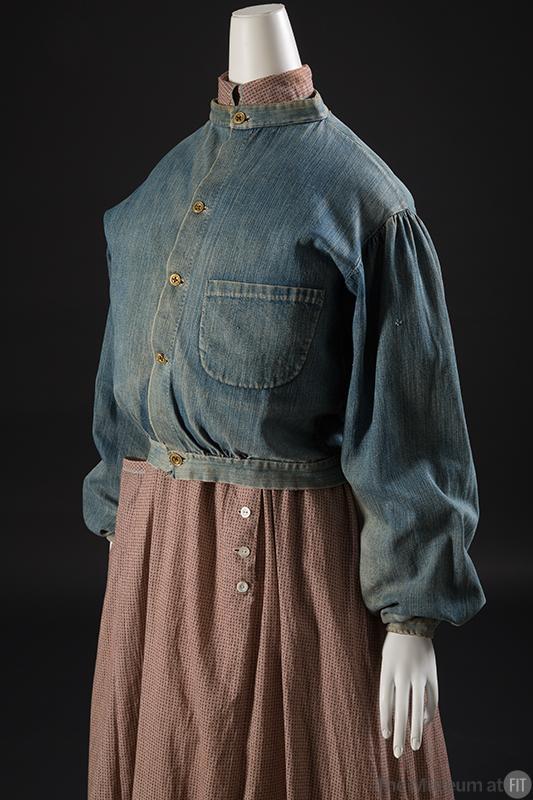
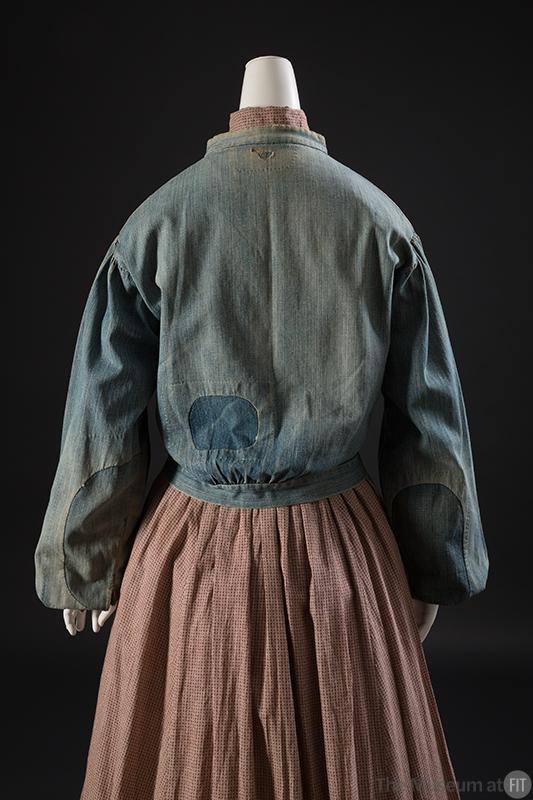
Denim Jacket
c.1850
United States
This jacket would have been worn over a woman’s work dress or blouse, most likely while she labored outdoors. Its construction mimics the fashionable hourglass silhouette of the period, with tucks that cinch at the wrists and natural waistline. Denim is typically thought of as a menswear textile, but it was also common in women’s workwear during the 19th century.
Museum at FIT (Object number: P87.43.3)
#jacket#outerwear#fashion history#historical fashion#1850s#19th century#crinoline era#united states#blue#denim#1855#museum at fit#popular
11K notes
·
View notes
Note
Top 5 historic clothing items we should bring back into style (stockings on men, big cuffs on coats etc.)
Well I am very biased, because my everyday clothes are mostly 18th century menswear inspired, but for a list as short as 5 it's good to narrow it down!
1. 18th century shirts. Big puffy soft linen shirts. Best shirts. Comfiest shirts. Though tragically, since they get softer with more washing, they're at their absolute most comfortable right before they wear out.
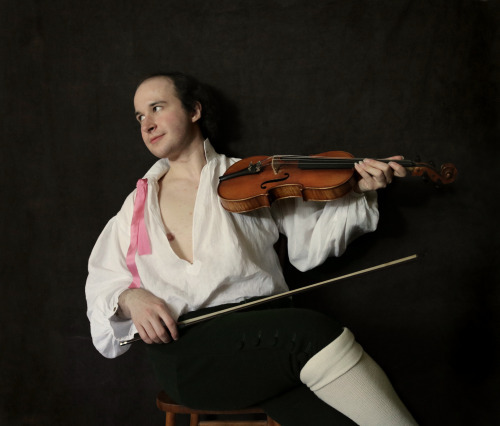
(This one's from the post where I copied the tiddy-out violinist painting.) Besides being the nicest softest comfiest, they're also the most economical, being made entirely from rectangles. And they're versatile, they look good with lots of different garments! Someday I will do a very detailed youtube tutorial for my machine sewn shirt method. I've done so many now that I think I've finally got it down.
2. Adjustable waistbands. Why did this ever stop being a thing? 18th century breeches have lacing at the back, then in the 19th century trousers have a buckle tab. Now they do not, even though we're all still humans with bodies that change. (These are my orange silk breeches)
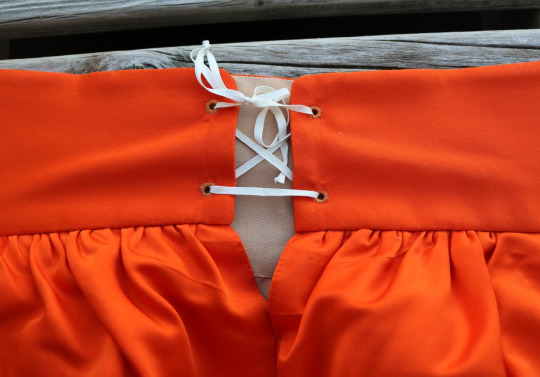
Do you know how many hours of my life I've spent taking in or letting out the waist seams of modern trousers? I don't know either, but I've been an alterations tailor since 2019, so it's got to be a fair amount.
All that waist altering wouldn't be necessary if they still made them adjustable! Waistlines fluctuate, so too should waistbands!!
3. Shoulder capes attached to coats. This was a thing in the late 18th century, and in the 19th, and I think into the early 20th too. It adds extra protection from the rain and snow, and it looks cool.
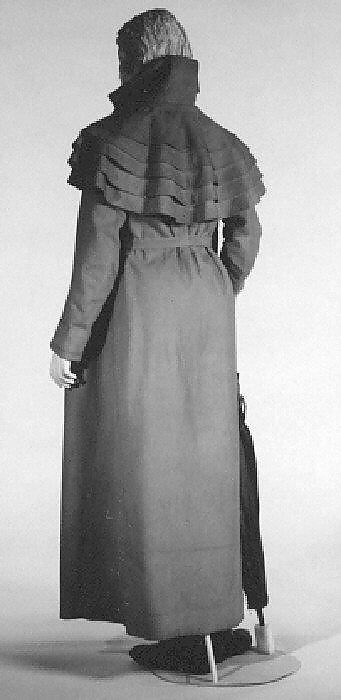
(c. 1812, The Met.)
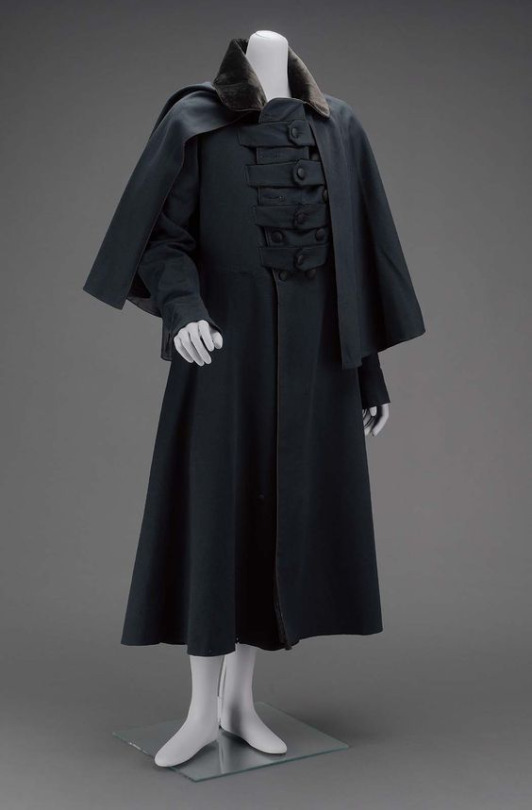
(c. 1840-60, MFA Boston. The cape on this one is detachable)
You can make them long or short, and stack them up like pancakes or just have one. I've got 2 small ones on my corduroy coat, and one on my dark blue wool. Both cut from almost the same 1790's-ish pattern.
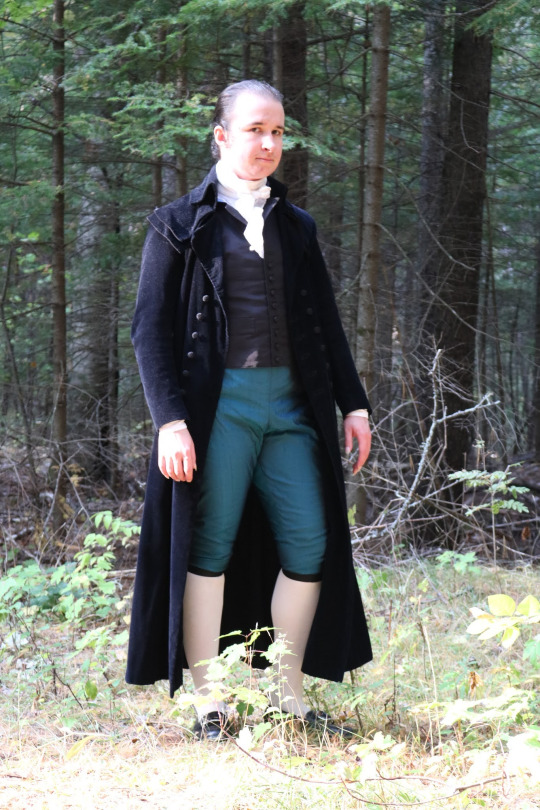
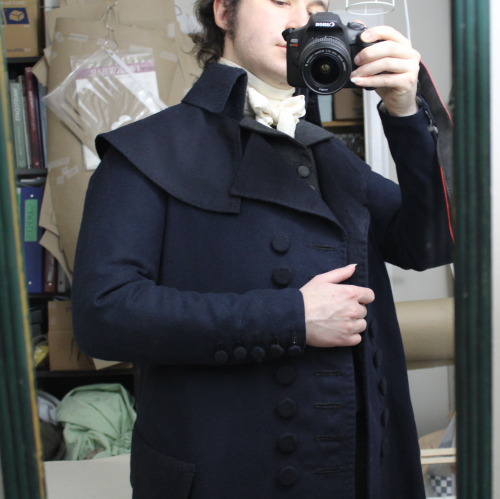
I also want to give a shoutout to fitted sleeves! I love me some two piece sleeves with a distinct elbow! And the coat pockets were bigger back then.
4. Indoor caps. I don't care what era or how fancy you go with it, I just want people to wear caps indoors when it's cold! This one's super simple, it's just a tube of linen tied with a ribbon.
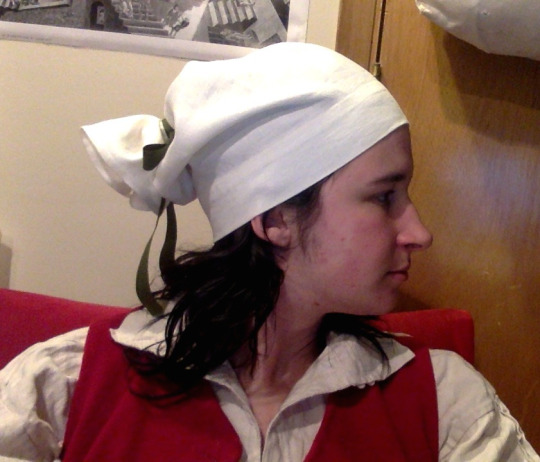

(Detail from Le Marchand d’Orviétan ou l’opérateur Barri by Etienne Jeaurat, 1743.)
If it's cold in your apartment you need slippers for the feets and a cap for the head. Speaking of which.
5. Medieval hoods. This one is wayyy outside my usual era, but the wintery below-freezing weather has just started here and the knit hat I've been wearing isn't quite long enough to cover my ears. I want to make a simple hat with ear flaps, but I also wouldn't be opposed to trying to work something vaguely similar to this into my wardrobe. It looks so warm!

(Image source. Also she has a printable pattern available!) I actually made one of these once, an entire decade ago. But it was scratchy blanket wool and I've since given it away.
That's some of the main things I think we should bring back! There are lots of other things too, like men's nightgowns, and waistcoats with little scenes embroidered on them, but for this list I tried to be mostly practical.
4K notes
·
View notes
Text
yap time
Junne's wardrobe is inspired by mostly
Norwegian bunad (18th-19th C, but I also looked at rental sites. I gave him a mix of womens and menswear)
Sámit clothing (for this I approximated my own weave and embroidery patterns, assigning colors and shapes to his hometown, profession, and religion. might be inaccurate vis-à-vis realistic weaving techniques but. I have to calm down) also nutukas
I do not care for historically accurate underwear so… wool shirt, nalbound socks, and the jockey formfits lmao
some Tang stuff (jiuyun style taohuazhuang, a bone zan that's been customized similarly to buyao (faux pas maybe lol)
something like a pleated dashao idk anymore
the top/outer cape of a (modified, bordering on inaccurate) suoyi and a douli
is anyone seeing my vision here or am I deluded as usual


brought a guy into the world but kept drawing him off model. it will probably keep happening
#been reading Barbara Sjoholm#I can't just be normal about things lately#I want to read more but I'm also wondering who tf is paying me to do that#when I'm just making a stupid little guy#drawing outfits for him#hwshln#juhani
40 notes
·
View notes
Text
Fashion History Books on Internet Archive

Illustration in La Mode by Paul Gavarni, c. 1835 (Rijksmuseum)
A selection of some of my favourites, free to read and check out once you create a (free) account!
Handbook of English Costume in the 19th Century, by C. Willett Cunnington and Phillis Cunnington. I can vouch for this as one of the greatest books in my collection, extensive menswear information. By the same authors: English costume in the Eighteenth, Seventeenth, and Sixteenth centuries.
A History of Men’s Fashion, by Farid Chenoune. A masterwork, absolute must-read primer on men’s fashion from the late 18th century to the late 20th century.
The Encyclopedia of World Costume by Doreen Yarwood. Covers many different cultures over a huge span of time so most topics are not treated in-depth, but still a great reference.
The History of Underclothes, by C. Willett Cunnington and Phillis Cunnington. Also covers men’s shirts in Western dress history, as these were considered undergarments.
Fashioning the Body: An Intimate History of the Silhouette, edited by Denis Bruna. A collection of essays on changing dress silhouettes in Western fashion over time, some of them very insightful.
The Dictionary of Fashion History, by Valerie Cumming. This is the first edition and I have the second, but my top fashion history dictionary and go-to for textiles and items of dress!
#fashion history#dress history#historical men's fashion#historical fashion#internet archive#open library#reference books#fashion#history#textiles#clothing#western fashion
357 notes
·
View notes
Note
Hi, I'm trying to make an late 18th century waistcoat something like the (1880's to the 1890's) but the problem is that I don't know what 1880's waistcoats look like Idk what collar they are supposed to have or what shape and yes I have searched on Google but they show so many different waistcoats even if I put 1880's in the search it shows me stuff from the 17th century so maybe you have references I could take a look at? Thank you❤ (it's supposed to be not long and I guess a little bit fancy)
So, 19th century, right? 1880s-90s menswear might be tricky to make, since it is almost modern tailoring, and of course tailoring is an entire different animal with their own stitches, pattern making methods, fit and construction. So, it might not be an easy project if you have no background in tailoring. BUT a waistcoat is kind of the easier garments to make in tailoring, so here we go.

What makes 19th century tailoring very particular to our modern eyes is the fitting over the body and the silhouette of the garments (especially the trousers). Waistcoats were fitted very close to the body, especially during the first half of the century (the ones from the 1830s-50s have marvelous fabrics and colours, along with that tight fit that kind of competed with the women’s silhouettes). The shape is short, with long, with or without a collar, and fitted at the waist.
Here some inspiration:

1890s fashion plate showing (from left to right): frock, three button sack, tuxedo dress suit, clerical, and full dress suit.

Fashion plate from New York (1899), depicting a frock coat, morning coat, and lounge suit.

Two men posing for a portrait, 1880-1890.


Silk vest, late 1870s–early 1880s, American or European, The Metropolitan Museum of Art.


Cotton vest, 1885–90, American or European, The Metropolitan Museum of Art.


Silk vest, 1880s, American or European, The Metropolitan Museum of Art.

Cord waistcoat with ivory buttons, 1880s, Great Britain, Victoria & Albert Museum.

Cashmere waistcoat, 1880-1889, Victoria & Albert Museum.
And an extra look for evening:

American full evening dress, c. 1890.

Tom Van Het Hof (@tom.van.het.hof in Instagram) wearing a vintage 1890s three-piece evening tailcoat.
------------------------------------------------------------------------------------
Some things you’ll have to keep in mind for this project:
The pattern is pretty easy to make, and here are instructions on how to make it (including how to take the measurements).
You’ll need two fabrics: the fashion fabric for the front and collar, and lining for the back.
Interlining is needed too, I prefer the one that is not iron-on (unless it’s your first time and boy, that is a lot easier).
Look for the stitches that you might need to use, especially if you decide to use decorative stitches.
Make a mock-up first. Always. And try it on a lot. The secret to the perfect fit is to try the mock on, adjust it, and make the needed changes.
DO NOT cut your real fabric until the mock-up is PERFECT.
296 notes
·
View notes